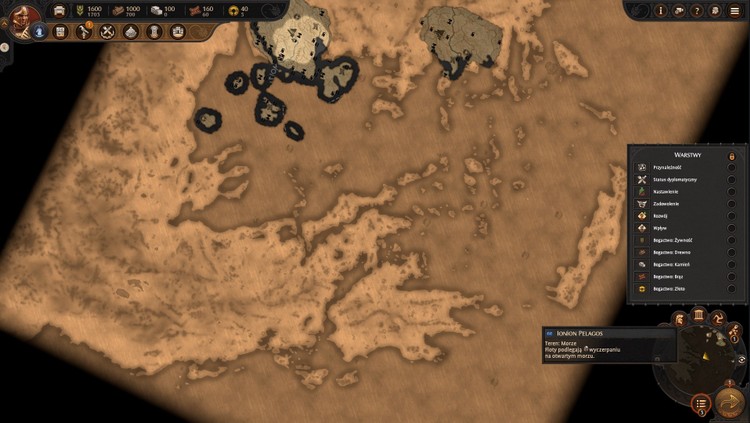

Along with a handful of crashes to desktop when opening certain interface windows, this all makes it clear that this odyssey could have used a little more polish. Epic heroes, likewise, will sometimes get stuck in an animation loop and be rendered useless, or do a 180 in the middle of the fray to launch a powerful area attack that only hits grass. All too often it results in them getting stuck on the terrain, or suicidally charging into the enemy melee troops for no clear reason instead of attacking and falling back like they’re supposed to.

These kinds of AI quirks extend to the battlefield as well, particularly with ranged units set to skirmish mode. And having practically infinite resources takes a lot of the tension and decision-making out of the strategy layer. But as the game goes on, scarcity decreases to the point that everyone can have everything they want, more or less. The flexibility of the barter system, which replaces money with other resources like wood, stone, and bronze, is great in theory especially with the stronger infantry requiring relatively scarce bronze to train and upkeep, I can see what the designers were going for. In Troy’s economy it’s possible to be producing enough food by Turn 50 to easily trade for whatever else you need. And you can’t have it when you inevitably come back next turn, either. No, Lycomedes, you can’t have 250 bronze for free. It’s an issue that used to crop up in older Total War games, but I had thought we were past it by now.
#Total war saga troy campaign map for free
While the convenient Quick Deal feature from Three Kingdoms makes a return, foreign leaders make a nuisance of themselves by spamming requests for absurdly lopsided trade deals, or constantly asking for free gifts of resources while offering nothing in return. Interacting with other leaders is often not as pleasant, though. Most historical strategy games act like nothing before Alexander the Great is even worth mentioning, so the novelty of a Bronze Age setting is refreshing and effective. And on the ground, when battle is joined, period-accurate mud brick houses and simplistic farms remind you just how far back in time we’ve travelled. Everything about this world and this interface radiates personality. Sailing into this unknown causes the edges to visually burn away in a fantastic, subtle effect. Undiscovered areas are covered in a beautiful weathered texture like baked clay, with ancient writing floating across the surface forebodingly. From the lush, hilly valleys of the Peloponnese to the rocky, rugged islands of the Cyclades scattered across the wine-dark sea, every corner is a joy to explore. The map, as I mentioned, is absolutely stunning.The map, as I mentioned, is absolutely stunning. There are also some special, discoverable objectives with unique rewards, like becoming Anax – basically a tribal king – of one of the map’s several geographic areas. Sometimes answering Agamemnon’s call to war can be a bit more trouble than it’s worth. This is a great nod to the source material, and helps further differentiate each campaign – and it’s great that it doesn’t get in the way if you want to pursue a more traditional Total War victory instead. These heroes also have their own dramatic, story-based win conditions called Homeric Victories that walk them through some of the highlights of their role in the Iliad, such as Menelaus having to reclaim Helen and Hector having to make sure the city of Troy does not fall.


 0 kommentar(er)
0 kommentar(er)
